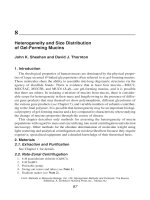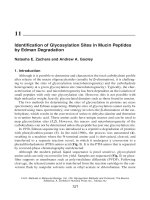Glycoprotein methods protocols - biotechnology 048-9-369-381.pdf
Bạn đang xem bản rút gọn của tài liệu. Xem và tải ngay bản đầy đủ của tài liệu tại đây (106.7 KB, 13 trang )
MAbs to Mucin VNTR Peptides 369
369
30
Monoclonal Antibodies to Mucin VNTR Peptides
Pei Xiang Xing, Vasso Apostolopoulos, Jim Karkaloutsos,
and Ian F. C. McKenzie
1. Introduction
One of the interesting technical aspects of working with mucins is that it is rela-
tively easy to make antibodies to different mucin glycoproteins—mainly because the
repeat sequences in the variable numbers of tandem repeat (VNTR) region are highly
immunogenic. Indeed, all the mucin genes (MUC1–MUC8) (1,2) were originally
cloned using polyclonal antisera and Escherichia coli DNA expressions systems, in
which, because of the repeated sequences, the expressed cDNAs could be detected and
cloned. We found this of particular interest because we had tried very hard in the early
days of cloning to isolate lymphocyte surface antigens with monoclonal antibodies
(MAbs)—all these efforts failed. Because the VNTRs are so highly immunogenic,
immunization of mice with human tumors, mucin-containing materials such as the
human milk fat globule membrane (HMFGM) (isolated from human milk), cell mem-
branes or synthetic peptides, all lead to the production of MAbs. We have made
numerous MAbs to human mucin 1, 2, 3, and 4 VNTRs; to variants, and to mouse
muc1 (3–8). As will be described herein it is not difficult to make these antibodies,
and, for the most part, these can be easily characterized and the antibodies recognize
linear amino acids of peptides—whether the peptides are present in tissues or as native
molecules (immunohistological detection), or the examination of synthetic peptides,
whether they are bound to a solid support, in solution, on pins with one end tethered,
or conjugated to other proteins, e.g., keyhole limpet hemocyanin (KLH). In almost all
circumstances, the reactions obtained are clear-cut, which contrasts with many other
antipeptide antibodies that react with nonlinear structures (requiring appropriate sec-
ondary or tertiary folding for detection), which makes detection erratic. We describe
here the methods used to make the antibodies and the principles of their characteriza-
tion. In addition, we summarize the properties of MAbs to human MUC1 VNTR pep-
tide; to MUC1 variant peptides; to MUC2, MUC3, MUC4 VNTR peptides; and to
mouse muc1.
From:
Methods in Molecular Biology, Vol. 125: Glycoprotein Methods and Protocols: The Mucins
Edited by: A. Corfield © Humana Press Inc., Totowa, NJ
370 Xing et al.
2. Materials
1. Cell culture medium: Dulbecco’s modified Eagle’s medium (DMEM) containing 2 mM
glutamine, 100 µL/mL of penicillin, 100 µg/mL of streptomycin, and 10% fetal calf serum
(FCS).
2. Tissue culture flasks, canted neck (Falcon, Becton Dickinson Labware, NJ).
3. Microtest tissue culture plate, 96-well flat-bottomed with low-evaporation lid (Falcon,
Becton Dickinson Labware, NJ).
4. Applied Biosystems Model 430A automated peptide synthesizer (Foster City, CA).
5. Reagents for peptide synthesis were purchased from Applied Biosystems, except for the
amino acid derivatives, which were purchased from Auspep (South Melbourne, Australia).
6. Anhydrous trifluoromethanesulfonic acid (TFMSA).
7. Liquid chromatography reversal-phase high-performance liquid chromatography (HPLC)
(Waters, Milford, MA).
8. Brownlee C8-Aquapore RP-300 column (Applied Biosystems, Foster City, CA).
9. Polyethylene pins (Pepscan) (Cambridge Research Biochemicals, Cambridge, UK) (9,10).
10. Human milk was obtained from nursing mothers, and mouse milk from lactating mam-
mary glands of nursing mice (11).
11. Buffers for preparation of HMFGM (Subheading 3.3.)
a. Buffered saline solution: 0.15 M NaCl, 2 mM MgCl
2
, 10 mM Tris-HCl, pH 7.4.
b. Medium buffer: 75 mM MaCl, 1 mM MgCl
2
, 5 mM Tris-HCl.
c. Sucrose buffer: 0.3 M sucrose, 70 mM KCl, 2 mM MgCl
2
, 10 mM Tris-HCl, pH 7.4.
12. Glutathione, insolublized on cross linked beaded agarose (Sigma, St Louis, MO).
13. Thrombin, Thrombostat, 5000 U/5 mL (Parke Davis).
14. pGEX2T vector (Pharmacia, Uppsala, Sweden).
15. KLH, Slurry (Calibiochem, La Jolla, CA).
16. Phosphate-bufferd saline (PBS), pH 7.4.
17. Complete Freund’s adjuvant (Sigma).
18. Female BALB/c mice.
19. Female Lewis rats.
20. Mouse myeloma cell line NS1.
21. Coating buffer: 0.05 M carbonate-bicarbonate buffer, pH 9.6.
22. Polyvinyl chloride (PVC) U-bottomed microtiter plates (Costar, Cambridge, CA).
23. 50X HAT solution: containing 0.8 mM thymidine (Sigma), 5 mM hypoxanthine (6-
hydroxypurine, Sigma). 20 µM aminopterin (Sigma).
24. Sheep antimouse immunoglobulin (Ig) conjugated with horseradish peroxidase (HRP,
Amersham, Buckinghamshire, UK).
25. Sheep antirat Ig labeled with HRP (Amersham).
26. Rabbit antimouse Ig linked to HRP (Dakopatts, Copenhagen, Denmark).
27. Antimouse subclass antibodies (Serotec, Oxford, UK).
28. Substrate buffer for enzyme-linked immunosorbent assay (ELISA):
a. 0.03% 2, 2-azino-bis-(3-ehtylbenzathiazoline 6-sulfonate (ABTS), in 0.1 M citrate
buffer, pH 4.0, containing 0.02% H
2
O
2
.
b. 0.05% ABTS, in 0.1 M citrate buffer, pH 4.0, containing 0.12% H
2
O
2
.
29. ELISA plate reader (Kinetic Reader, Model EL312E, BIO-TEK Instruments, Inc.,
Winsooki, VT).
30. Buffers for ELISA to test peptide on pins:
a. Blocking buffer: of ELISA to test peptide on pins: 1% ovalbumin, 1% bovine serum
albumin (BSA), 0.1% Tween-20 in PBS, pH 7.2, and 0.05% sodium azide.
MAbs to Mucin VNTR Peptides 371
b. Disruption buffer: 1% sodium dodecyl sulfate (SDS), 0.1% 2-mercaptoethanol, 0.1 M
sodium dihydrogen othophosphate.
31. Sonicator (Unisonics, Sydney, Australia).
32. O.C.T. Compound (Tissue-Tek, Torrence, CA).
33. Aminoalkylsilane coated slides (12).
34. Microtome Cryostat HM 500 OM (Microm Laborgerate, Waldorf, Germany)
35. 3,3 Diaminobenzidine (DAB) (Sigma), 1.5 mg/mL in PBS containing 0.1% H
2
O
2
.
36. Electrophoresis power supply, EPS 500/100 (Phamacia, Uppsala, Sweden).
37. Flow cytometer (Becton Dickson).
38. 50% polyethyelene glycol 4000 (Merck, Darmstadt, Germany) in DMEM.
39. 37°C, 10% CO
2
in a humidified incubator.
40. BIAcore™ 2000 biosensor (Pharmacia) (13). CM5 sensor chip and the amine coupling kit (14).
3. Methods
3.1. Solid-Phase Peptide Synthesis
The peptides were produced using an Applied Biosystems Model 430A automated
peptide synthesizer, based on the standard Merrifield solid-phase synthesis method
(15,16). All reagents for synthesis were purchased from Applied Biosystems, except
for the amino acid derivatives, which were purchased from Auspep.
3.1.1. Peptide Synthesis
Solid-phase peptide synthesis (SPPS) was formulated by Merrifield (15). The con-
cept has undergone many improvements and is now a widely established technique.
1. Synthesis occurs from the carboxyl to the amino terminal of the peptide. The α-carboxyl
group of the C-terminal amino acid is covalently bonded to an insoluble polystyrene resin
bead via an organic linker.
2. The α-amino group of this amino acid and all subsequent amino acids used in the synthe-
sis are protected by an organic moiety. There are two fundamental organic moieties that
serve as protecting groups of the α-amino group: tertiary butyloxycarbonyl (tBOC), which
is acid labile; and fluorenylmethyloxycarbonyl chloride (Fmoc), which is base labile. In
our study, tBoc chemistry was employed to synthesize the MUC1, MUC2, MUC3, and
MUC4 peptides. There are three sites on an amino acid that are potentially reactive: the
α-amino group (NH
2
), the carboxyl group (COOH), and at certain side-chain functional
groups (R). The carboxyl group is not chemically protected because it is the site that
forms an amide bond with the α-amino group of the amino acid that was previously
coupled to the growing peptide chain.
3. The synthesis cycle consists of three chemical reactions repeated for each amino acid:
a. Deprotection: This is carried out by using trifluoroacetic acid (TFA) to effectively
remove (deprotect) the tBoc protecting group. This procedure allows the next amino
acid to react at that site to form an amide (peptide) bond.
b. Activation: This involves the formation of symmetric anhydrides that are very effec-
tive, activated carboxyl forms of amino acids. Dicyclohexylcarbodimide (DCC) was
used to generate symmetric anhydrides. There are three amino acids that do not form
stable symmetric anhydrides, and they can begin to degrade within 4 min of forma-
tion. The three amino acids asparagine, glutamine, and arginine are coupled as
1-hydroxybenzotriazole (HOBt) esters. When DCC/HOBt activation is utilized, sig-
nificantly improved coupling is achieved.
372 Xing et al.
c. Coupling: This occurs when the activated amino acid (symmetric anhydride) forms
an amide bond (CO-NH) with the growing peptide chain.
3.1.2. Postsynthesis: Cleavage
When a peptide has been synthesized, it is then “cleaved.” Cleavage is the process
that chemically “cuts” (cleaves) the peptide from the resin and any side chain protect-
ing groups that are present. The chemical linkers and protecting groups used in tBoc
peptide synthesis normally require very harsh conditions for effective removal. Pow-
erful acids, such as hydrofluoric acid (HF) or TFMSA are needed in conjunction with
scavengers. Scavengers are chemical moieties that have the ability to bind irreversibly
to amino acid protecting groups. These trapped cations are thus prevented from under-
going further reactions. There are numerous varieties of scavengers. Ethanedithiol
(EDT) has proved to be a most efficient scavenger for tertiary-butyl protecting groups
(a widely used protecting group). However, using a combination of scavengers is usu-
ally necessary. Thioanisole, water, phenol, p-cresol, phenol, and dimethylsulfide, to
name a few, have also been shown to be efficient scavengers in trapping protecting
groups and suppressing certain reactions from taking place (such as alkylation when
tryptophan or methionine are present in the peptide sequence) that would otherwise
proceed under normal cleavage conditions.
1. The cleavage mixture incorporated for the MUC1, MUC2, MUC3, and MUC4 peptides is
80% TFA, 8% TFMSA, 8% thioanisole, and 4% EDT. The mixture is allowed to react
with the peptide-resin for 30 min at room temperature.
2. After this time, the entire contents are filtered.
3. Thirty milliliters of chilled diethyl ether is used to precipitate the peptide, which is then
centrifuged and the supernatant discarded.
4. The pellet (crude peptide) is then dissolved with 6 M of guanidine hydrochloride, pH 7.5.
Care must be taken when selecting for appropriate scavengers, for instance, water is an
essential scavenger when using Fmoc synthesis. The combination of scavengers implemented
is determined by that protecting groups present on the peptide. The type of acid needed is
determined by the binding strength of the organic linker and side-chain protecting groups. As
an example, the organic linkers and protecting groups for Fmoc synthesis can be readily
cleaved with TFA. tBoc synthesis requires much stronger acids such as HF or TFMSA.
3.1.3. Purification
The method of choice for peptide purification is reversed-phase HPLC. This tech-
nique separates compounds based on the principles of hydrophobicity.
1. The peptides are purified using a Waters Model 441 HPLC, on a C8-Aquapore RP-300
column (Brownlee) using a gradient solvent system of 0.1% aqueous TFA 0.1% TFA,
39.9% H
2
O, and 60% CH
3
CN.
The purity of synthetic peptides was approx 90% as judged by HPLC and mass
spectometry.
3.1.4. The Peptides Synthesized
The peptides synthesized were derived from the MUC1, MUC2, MUC3, MUC4
peptides, which include (Table 1):
MAbs to Mucin VNTR Peptides 373
1. MUC1 VNTR peptide: the peptide Cp13-32, derived from MUC1 VNTR region (contain-
ing an N-terminal cysteine to form dimers); peptides from N- and C-terminal regions to
the VNTR, and cytoplasmic tail peptides of MUC1. The peptides were named by either
position number in the protein sequence (e.g., p344–364, Table 1) or in a two continuous
20-amino acid repeats (e.g., p1–40, Table 1), or by individual amino acid name com-
bined with the following peptide name, e.g., A-p1-15 (Table 1).
Table 1
Synthetic Peptides Used in Our Study
Peptide Amino acid sequence
a
MUC1
VNTR
p1-40 PDTRPAPGSTAPPAHGVTSA
PDTRPAPGSTAPPAHGVTSA
p1-24 PDTRPAPGSTAPPAHGVTSAPDTR
p5-20 PAPGSTAPPAHGVTSA
p13-32 PAHGVTSAPDTRPAPGSTAP
C-p13-32 (C)PAHGVTSAPDTRPAPGSTAP
p1-15 PDTRPAPGSTAPPAH
A-p1-15 APDTRPAPGSTAPPAH
N-terminal to VNTR
p31-55 TGSGHASSTPGGEKETSATQRSSVP
p51-70 RSSVPSSTEKNAVSMTSSVL
C-terminal to VNTR
p344-364 NSSLEDPSTDYYQELQRDISE
p408-423 TQFNQYKTEAASRYNL
Cytoplasmic tail of MUC1
p471-493 AVCQCRRKNYGQLDIFPARDTYH
p507-526 (C)YVPPSSTDRSPYEKVSAGNG
CT18 (C)SSLSYTNPAVVTTSANL
Variants of MUC1
SP11 (splicing peptide) (CY)TEKNAFNSS
sMUC1 (secreting peptide) VSIGLSFPMLP
MUC2
MI-29 (KY)PTTTPISTTTMVTPTPTPTGTQTPTTT
MUC3
SIB-35 (C)HSTPSFTSSITTTETTSHSTPSFTSSITTTETTS
MUC4
M4.22 (C)TSSASTGHATPLPVTDTSSAS
MUC5
M5 (C)HRPHPTPTTVGPTTVGSTTVGPTTVGSC
Mouse muc-1
MP26 (C)TSSPATRAPEDSTSTAVLSGTSSPA
Mouse CD4
T4NI KTLVLGKEQESAELPCECY
a
(C), (CY), (KY): These extra amino acids were added to the peptide.









